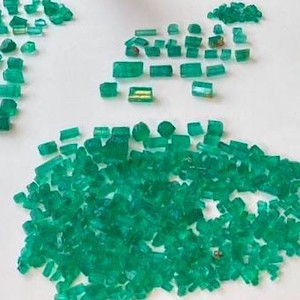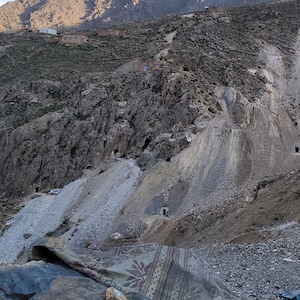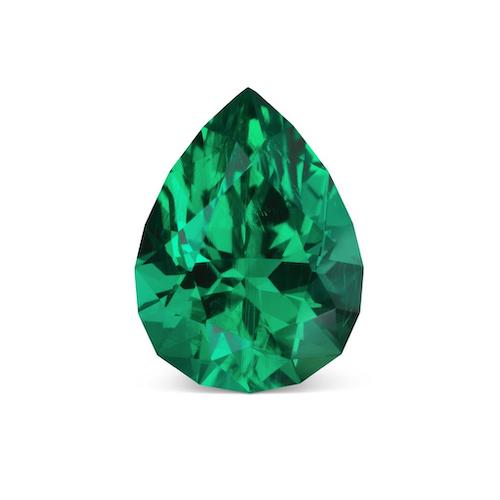
Last week, President Biden began withdrawing American troops from Afghanistan after two decades, ending the longest war in U.S. history. Shortly afterward, Taliban forces overran the Afghan army and assumed control of most of the country.
Afghanistan is a major gem producer, and its colored stone sector could turn into a political football, like Burma’s rubies did after that country’s military coup.
“This change in administration could be highly consequential for the gemstone business,” says Mary Louise Vitelli, a U.S. lawyer who worked with the Afghan government to develop its mining framework, and who lived in the country from 2003 to 2009.
Afghanistan is far and away the world’s preeminent source of lapis lazuli. It also produces rubies and tourmaline, but emeralds are its main money earner; in 2018, the country exported around $100 million worth of the gems, InColor reported.
Its emerald hub, the mountainous Panjshir Valley, is one of the few areas of the country not currently under Taliban control. In fact, the heavily fortified region has never been ruled by the Taliban, even when the group controlled the country from 1996 to 2001.
Locals there have been resisting the new order, and that’s brought emerald production to a halt, says Zahed Faheem, a Dubai, United Arab Emirates–based sales executive with Panjshir Gems.
“[Activity] at the emerald mines in Panjshir has been halted, and miners have no choice other than to take up arms and join the resistance to protect their lives and livelihoods,” he says. “People are very wary of leaving the province because Taliban terrorists are present in all of the surrounding provinces. We cannot safely transport rough emeralds out of the province, and even if we could bring them to Kabul, the airport is completely shut off.”

Like most of Afghanistan’s gem sector, the country’s emerald mines are mostly small-scale, with diggers using primitive tools. Most gems are sold outside of official channels.
“Only about 5% of the mines are even registered,” says Michael Peters, CEO of Panjshir Valley Emeralds, which sells responsibly sourced emeralds tracked by blockchain. “They are family owned. The mines used to be somebody’s goat farm until they found gems there.”
One of the things his company has tried to do, he says, is modernize the region’s mining methods.
“Miners there had been using expired Russian dynamite. Not only was that dangerous, it was blowing up a lot of the product.”

Similarly, Gary Bowersox, president of Gem Hunters Corp., had been working for years to bring Afghan gems to the larger market. A consultant for the U.S. Agency for International Development (USAID), he’s spent the last few months organizing an emerald trade show in Dubai featuring $38 million in goods. Now, he has no idea if the event will happen, and whether he or USAID will remain involved in the sector.
A lot depends on the new government, and how it behaves going forward, Bowersox says.
“Even the Taliban will want to restart the gem trade,” he says. “If they were to shut down the emerald mines in Panjshir, there would be no income there. A lot of people in Kabul are traders or dealers.”
The resurgent group has moderated its public rhetoric, and there’s some hope—though not a lot of confidence—that it will govern more pragmatically than in the past, if only to attract foreign investment.
Peters is cautiously optimistic: “There will be some crazies that make it look bad for everyone. But the tribal leaders on the ground in the middle of this have been treated very respectfully. The Taliban leadership has grown older, they have become educated, they are approaching the world differently. They know that economic development is the key to the future. If they don’t have that, they won’t be able to maintain their government.”
On the other hand, if the Taliban acts like it did in the 1990s—harboring terrorists and brutally repressing its citizens, particularly women—the United States and its allies might try to bleed it economically, which could include a gem ban. The Biden administration has already blocked millions in Afghan government funds held in U.S. banks, and national security adviser Jake Sullivan has suggested sanctions are possible.
Whatever the merits of these policies, they risk hurting the country’s poorest citizens, warns Zulaikha Aziz, the Afghan-born founder of the Mazahri jewelry line. Aziz, who is also a human rights attorney, recognizes the industry must comply with any changes in the law, but she hopes that, for now, the jewelry business won’t turn its back on Afghanistan and its nearly 39 million people.
“Most of the country does not support the Taliban,” says Aziz, whose family came to the United States in the 1980s as refugees from the Soviet invasion of the country. “The Afghan people already feel abandoned. It would be a huge blow to the artisanal and small-scale miners if we start boycotting their products. People will go hungry.
“Afghanistan has some of the most magical stones in the world. These beautiful gems are ancient creations. They come from the land. Families have lived off these mines for generations. They have the potential to improve people’s lives. It’s important to us as jewelers, as gem suppliers, as an extractive industry, to keep learning and caring about the people who are getting this material for us.”
After the U.S.-led invasion of Afghanistan in 2001, most outside donors were interested in large mining operations rather than the small-scale sector, even though that’s how most Afghan gems are produced, Vitelli says. And while there were periodic attempts to boost artisanal diggers, “they were not as significant as they could have been because everyone was focused on the large scale,” she adds. Even the occasional formalization efforts sometimes went awry.
“Current government regulations require duties, royalties, and taxes that total more than 50% of the [emeralds’] value,” Bowersox wrote in 2015. “Ample evidence exists of government employees demanding that emerald miners and traders pay ‘baksheesh,’ or a bribe, to obtain any required paperwork, including permission to export.”
These sorts of corrupt dealings were all too common during the U.S. occupation, says Aziz. She lived in Afghanistan sporadically after the 2001 invasion and wasn’t surprised that the government of former president Ashraf Ghani collapsed so quickly.
“It didn’t have to end this way. When I went to Afghanistan in 2002, the people were hungry and hopeful. There will be years of testimony and books about all the mistakes that were made, all the incompetence. The U.S. chose actors that were not working in the best interest of the people. No country wants a government that doesn’t represent the people.”
Bowersox, who has been visiting the country for the last five decades, believes that the odds were always against things working out the way the United States wanted.
“There were just a lot of mistakes made, some of them excusable, some of them not so excusable,” he says. “You go into a totally unknown situation, you don’t know what is going to happen. It takes you a while to figure things out.
“America, Russia—all these big countries are foreigners. Afghanistan has always been controlled by foreigners. They have always been fought over. If China took over in Washington, D.C., next week, we wouldn’t be happy.
“People don’t want foreigners coming in and telling them what to do. They just want the foreigners to go home.”
Aziz recommends anyone wishing to support the people of Afghanistan donate to Women for Afghan Women, Turquoise Mountain Trust, the Afghan American Artists and Writers Association, or the International Rescue Committee, which helps and advocates for refugees.
Top: A table full of Afghan emeralds (photo: Gary Bowersox/courtesy of Gary Bowersox)
Follow JCK on Instagram: @jckmagazineFollow JCK on Twitter: @jckmagazine
Follow JCK on Facebook: @jckmagazine





